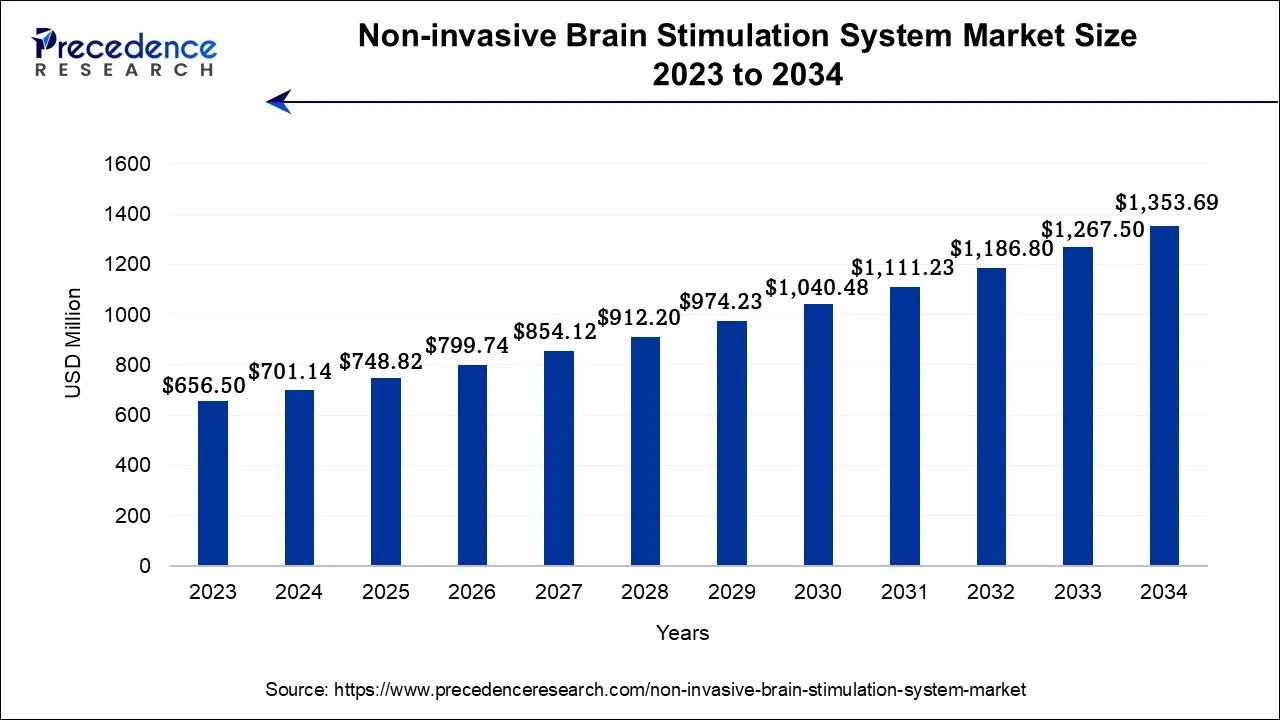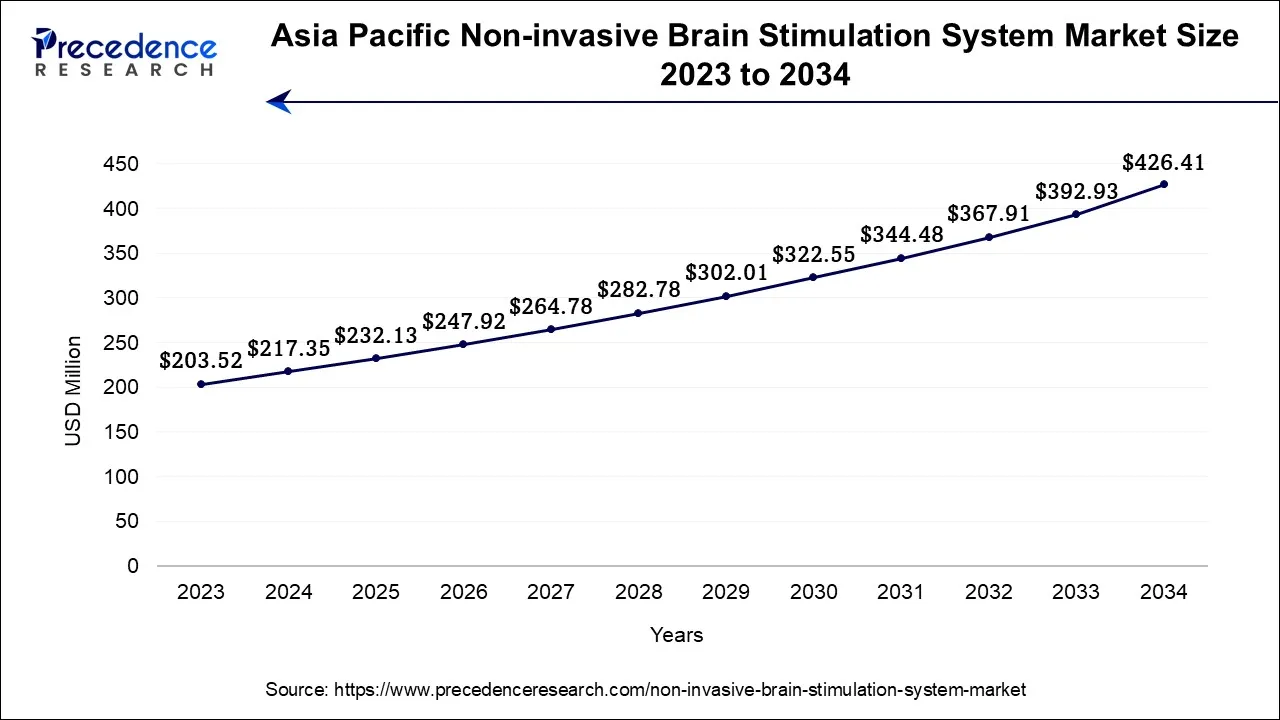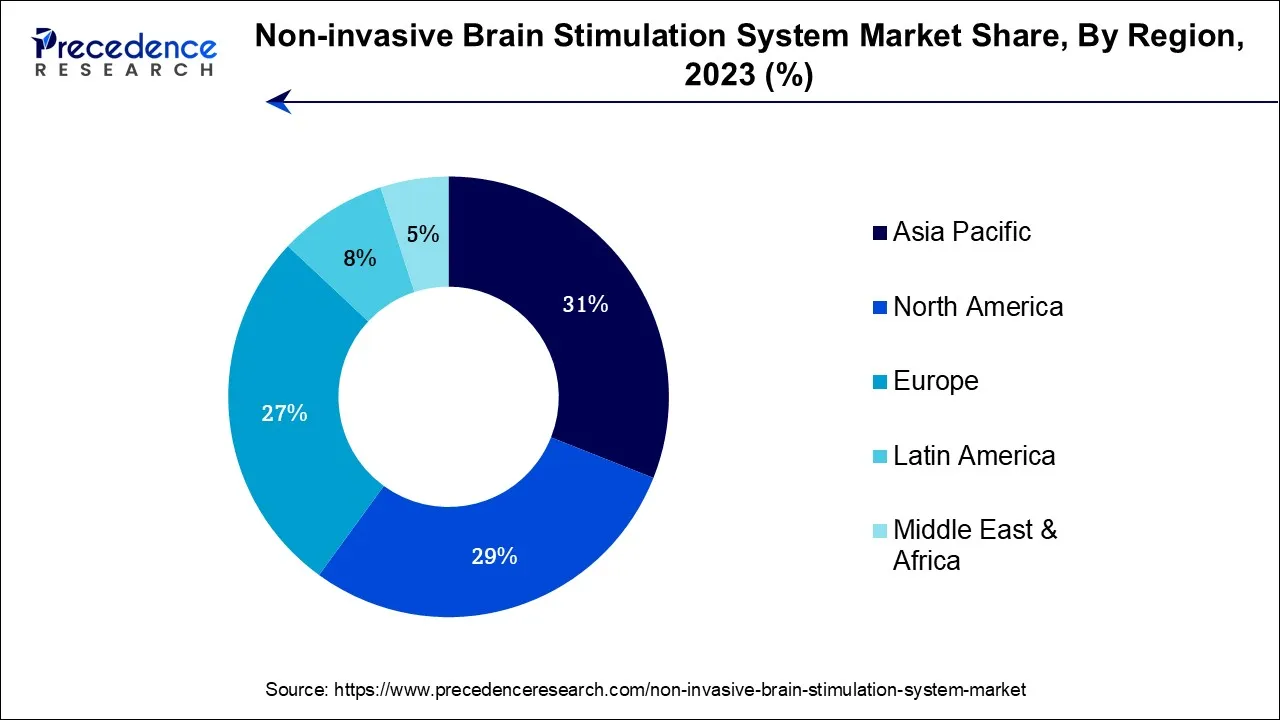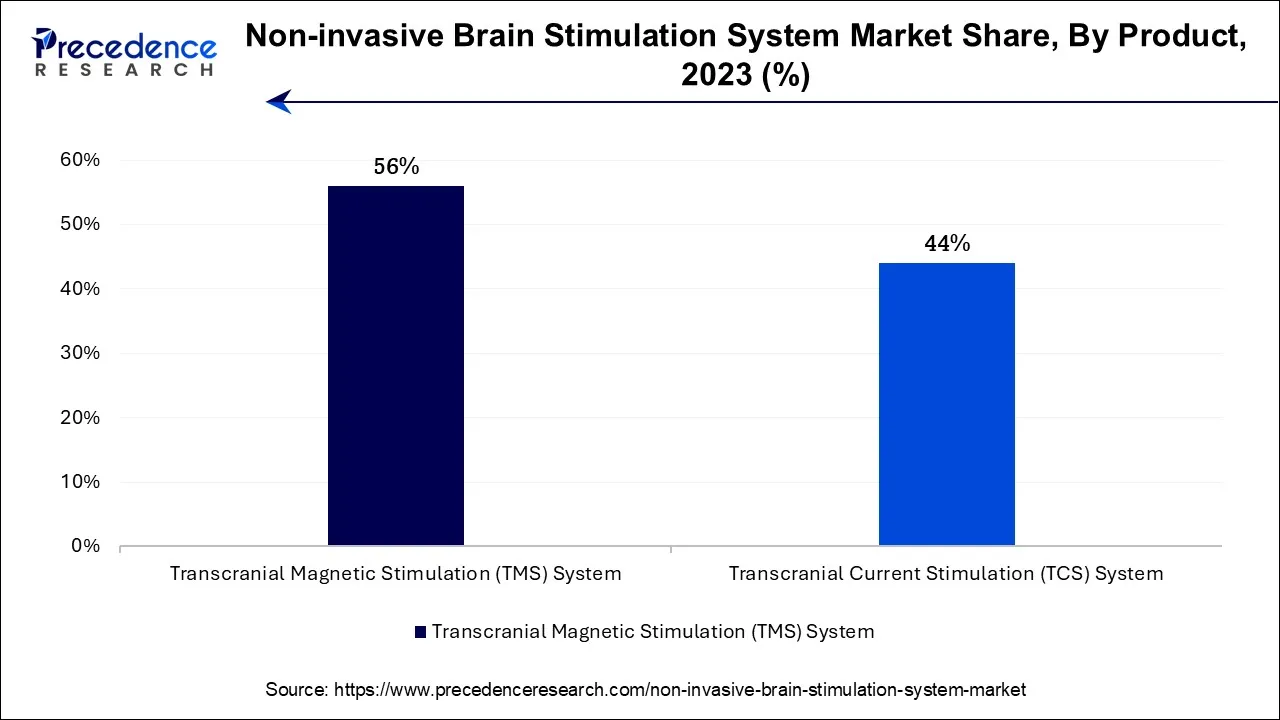August 2024
The global non-invasive brain stimulation system market size is calculated at USD 701.14 million in 2024, grew to USD 748.82 million in 2025, and is predicted to hit around USD 1,353.69 million by 2034, poised to grow at a CAGR of 6.8% between 2024 and 2034. The Asia Pacific non-invasive brain stimulation system market size accounted for USD 217.35 million in 2024 and is anticipated to grow at the fastest CAGR of 6.97% during the forecast year.
The global non-invasive brain stimulation system market size is expected to be valued at USD 701.14 million in 2024 and is anticipated to reach around USD 1,353.69 million by 2034, expanding at a CAGR of 6.8% over the forecast period from 2024 to 2034.

The Asia Pacific non-invasive brain stimulation system market size is accounted for USD 217.35 million in 2024 and is projected to be worth around USD 426.41 million by 2034, poised to grow at a CAGR of 6.97% from 2024 to 2034.

Asia-Pacific has held the largest revenue share 31% in 2023. The Asia-Pacific region's commanding presence within the non-invasive brain stimulation system market is underpinned by a compelling set of dynamics. It currently stands amidst vigorous economic growth, ushering in heightened investments in healthcare infrastructure and fostering the adoption of cutting-edge medical technologies. Additionally, the region's substantial population demographic contributes to an elevated prevalence of neurological and psychiatric disorders, creating a robust demand for non-invasive brain stimulation systems. Furthermore, increasing consciousness of mental health issues and the healthcare sector's growing penchant for innovative solutions collectively propel market expansion in the Asia-Pacific, solidifying its pivotal status on the global market landscape.

North America is estimated to observe the fastest expansion. North America commands substantial growth in the non-invasive brain stimulation system market due to compelling factors. Firstly, its healthcare landscape is distinguished by a robust infrastructure, cutting-edge research institutions, and substantial healthcare investments, facilitating the assimilation of innovative medical technologies such as non-invasive brain stimulation systems. Secondly, the region witnesses a burgeoning prevalence of neurological disorders, coupled with heightened awareness regarding the efficacy of non-invasive treatments, thereby propelling market expansion. Thirdly, North America serves as an epicenter for pioneering research and development endeavors, fostering technological breakthroughs and extensive clinical investigations. Lastly, the region benefits from favorable reimbursement policies and a proactive regulatory milieu, further galvanizing market growth.
The non-invasive brain stimulation system market encompasses the sector focused on the development and provision of technologies designed to influence brain activity without resorting to surgical or intrusive methods. These systems leverage methodologies such as transcranial magnetic stimulation (TMS) and transcranial electrical stimulation (tES) to modulate brain functions, serving both therapeutic and investigative purposes.
The market is experiencing expansion due to heightened interest in neuroscience and mental health treatments. Its applications span from treating depression and managing pain to enhancing cognitive capabilities. This dynamic market is characterized by continuous research, technological innovations, and a diversity of companies offering devices and solutions to cater to medical, clinical, and research requirements.
The non-invasive brain stimulation systems market is an emerging sector that is committed to the advancement of cutting-edge technologies that can manipulate brain function without resorting to intrusive procedures. This sector has witnessed substantial expansion, driven by a convergence of factors.
The non-invasive brain stimulation system market has experienced notable growth recently, encompassing technologies such as transcranial magnetic stimulation (TMS) and transcranial electrical stimulation (TES), offering therapeutic and research applications. Industry leaders are dedicated to refining these technologies to meet the diverse demands of the medical, clinical, and research domains, rendering it a dynamic and swiftly evolving sphere.
Numerous elements contribute to the burgeoning of this market. Foremost among these is the surging interest in neuroscience and mental health treatments, which stimulates both research and commercial applications. Non-invasive brain stimulation systems have gained acclaim for their potential in addressing conditions like depression and the management of persistent pain. Moreover, the proliferation of cognitive enhancement therapies and their applicability in neurological disorders further stoke market expansion.
Moreover, the advent of cutting-edge technologies and a more profound comprehension of brain functions have cleared the path for ingenious solutions. This encompasses the advent of personalized treatment options, as non-invasive brain stimulation systems can be customized to individual patients, heightening their efficacy and attractiveness in the medical sector.
Despite its promising prospects, the non-invasive brain stimulation system market encounters challenges. Regulatory obstacles and the need for stringent clinical validation represent hurdles to market growth.
Additionally, intense competition among industry participants striving to create more efficient and cost-effective devices is a persistent challenge. Furthermore, addressing ethical concerns and potential side effects associated with brain stimulation therapies is imperative to foster public trust.
Within these challenges, numerous business prospects emerge within the non-invasive brain stimulation system market. Collaborative ventures between technology enterprises and research institutions can lead to groundbreaking discoveries and inventive solutions. Expanding the scope of applications beyond healthcare, such as into the realm of cognitive enhancement, opens up new avenues for revenue.
Furthermore, global market penetration is still in its initial stage, presenting opportunities for market players to broaden their reach into untapped regions. As the comprehension of neurobiology and brain function continues to evolve, the development of pioneering non-invasive brain stimulation systems promises to unlock unexplored therapeutic avenues, positioning the industry for sustained growth in the future.
| Report Coverage | Details |
| Growth Rate from 2024 to 2034 | CAGR of 6.8% |
| Market Size in 2024 | USD 701.14 Million |
| Market Size by 2034 | USD 1,353.69 Million |
| Largest Market | Asia Pacific |
| Base Year | 2023 |
| Forecast Period | 2024 to 2034 |
| Segments Covered | By Product, By End-user, and By Application |
| Regions Covered | North America, Europe, Asia-Pacific, Latin America, and Middle East & Africa |
Rising interest in neuroscience
The escalating intrigue surrounding neuroscience serves as a pivotal catalyst in driving the expansion of the non-invasive brain stimulation system market. As understanding of the intricacies of the brain's inner workings deepens, an ever-growing curiosity emerges, fueling exploration into its enigmatic facets and potential therapeutic applications. This heightened fascination not only energizes intensive research endeavors but also sparks a surge of entrepreneurial initiatives within this domain.
Neuroscience has seamlessly transitioned from its erstwhile niche status to a prominent and mainstream sphere of study, wherein researchers, clinicians, and healthcare professionals increasingly grasp the paramount significance of non-invasive brain stimulation systems in advancing our comprehension of cerebral processes and addressing a spectrum of neurological and psychiatric disorders.
Furthermore, the convergence of neuroscience with allied disciplines like artificial intelligence and machine learning has unlocked fresh avenues for innovative applications and treatment methodologies, drawing substantial investments and attracting exceptional talent, thereby propelling the evolution of cutting-edge non-invasive brain stimulation technologies. In essence, the burgeoning enthusiasm for neuroscience operates as a pivotal driving force for the non-invasive brain stimulation system market, propelling multifaceted research pursuits, fostering pioneering innovations, and cementing these technologies as indispensable instruments for delving into the intricacies of the human brain and elevating healthcare outcomes.
Limited efficacy evidence
The constraint of limited efficacy evidence significantly hampers the non-invasive brain stimulation system market's growth trajectory. Despite their promising therapeutic and research potential, the absence of robust and extensive clinical data verifying their effectiveness across a spectrum of applications acts as a formidable impediment. Healthcare providers and institutions often demand well-substantiated outcomes and safety profiles before embracing novel technologies, and the dearth of comprehensive evidence regarding the efficacy and safety of non-invasive brain stimulation systems for a broad range of neurological and psychiatric conditions creates hesitancy in their adoption, particularly within clinical environments.
Furthermore, this dearth of conclusive evidence can lead to challenges in securing reimbursement and insurance coverage, thereby posing financial barriers to patient access. Mitigating this constraint necessitates continued and rigorous clinical trials, research collaborations, and the dissemination of data to establish a robust evidentiary foundation for non-invasive brain stimulation systems, ultimately bolstering confidence among healthcare professionals and patients alike.
Expanding clinical applications
The expansion of clinical applications within the non-invasive brain stimulation system market creates a landscape rich with opportunities. Beyond their established role in addressing neurological and psychiatric conditions, these systems are now exploring a diverse range of therapeutic frontiers, opening up substantial avenues for growth. Particularly noteworthy is their promising foray into the realm of chronic pain management, where they have exhibited efficacy in mitigating persistent pain syndromes. Additionally, the burgeoning field of cognitive enhancement presents a novel frontier, with the potential to elevate memory, concentration, and overall cognitive function.
Furthermore, non-invasive brain stimulation is actively being investigated for post-brain injury rehabilitation, facilitating recovery and cognitive recuperation. This diversification not only widens the market's horizons but also attracts a broader array of healthcare practitioners and patients, laying the groundwork for potential collaborations with specialists in pain management, rehabilitation, and cognitive neuroscience. As the evidentiary support for these applications solidifies, it not only augments acceptance but also propels the market toward innovative trajectories, promising substantial growth prospects.
According to the product, the transcranial current stimulation (TCS) System segment has held a 56% revenue share in 2023. The dominance of the Transcranial Current Stimulation (TCS) System segment in the market can be attributed to its adaptability and efficacy. TCS systems provide versatile, non-invasive methods for modulating brain functions, rendering them invaluable for both research and clinical purposes. They have garnered recognition across a spectrum of neurological and psychiatric disorders, including applications in managing conditions like depression and chronic pain.
Moreover, their relative simplicity and cost-effectiveness, when compared to alternative methods such as transcranial magnetic stimulation (TMS), have increased their accessibility, resulting in a substantial market share and widespread adoption.

The transcranial magnetic stimulation (TMS) system segment is anticipated to expand at a significantly CAGR of 7.7% during the projected period. The prominence growth of the transcranial current stimulation (TCS) system segment within the market can be ascribed to its remarkable adaptability and firmly established efficacy. TCS systems offer a non-invasive and uncomplicated approach to modulating brain activity, rendering them applicable to an extensive array of scenarios. They have demonstrated their mettle in managing conditions such as depression, chronic pain, and cognitive disorders. Furthermore, TCS systems often represent a cost-efficient and user-friendly alternative compared to other non-invasive brain stimulation modalities, making them a magnet for diverse healthcare providers and researchers.This fusion of versatility, proven effectiveness, and ease of adoption has firmly entrenched TCS systems as a dominant growth in the market landscape.
In 2023, the hospitals segment had the highest market share of 31% on the basis of the End-use. Hospitals wield substantial influence over the non-invasive brain stimulation system market share for a constellation of distinct reasons. To begin with, hospitals inherently function as central nerve centers for the diagnosis and therapeutic management of neurological and psychiatric ailments, naturally positioning them as pivotal users of these cutting-edge systems.
Furthermore, the specialized administration of non-invasive brain stimulation, often necessitating the competence of healthcare experts, finds an ideal home in the well-equipped and proficient hospital environment. Additionally, the progressive acknowledgment of the efficacy of these therapies in addressing conditions such as depression and chronic pain has seamlessly woven them into the fabric of hospital treatment paradigms. This intricate interplay of factors undeniably solidifies hospitals as prominent contributors to the market's overall share and influence.
The specialty clinics is anticipated to expand at the fastest rate over the projected period. The Specialty Clinics segment holds significant growth in the non-invasive brain stimulation system market due to several factors. Specialized clinics are equipped with the expertise and infrastructure necessary to administer precise and tailored treatments using non-invasive brain stimulation technologies. They often serve as centers of excellence for specific neurological or psychiatric conditions, attracting patients seeking specialized care. Moreover, these clinics tend to have the resources for conducting clinical trials and research, further advancing the field. As a result, they have a substantial influence on shaping best practices and driving the adoption of non-invasive brain stimulation therapies, contributing to their dominant market growth.
The depression segment held the largest revenue share of 34% in 2023. The depression segment commands a significant share within the non-invasive brain stimulation system market for several compelling reasons. Firstly, the pervasive global prevalence of depression fuels the need for efficacious interventions. Non-invasive brain stimulation systems emerge as an appealing option, offering an alternative or supplementary approach with fewer associated side effects than conventional treatments.
Furthermore, the continuous stream of research and clinical investigations continually corroborates the effectiveness of these systems in addressing depression, thereby fortifying their foothold in the market. The escalating recognition of mental health challenges and a burgeoning preference for non-pharmacological therapeutic avenues collectively contribute to the pre-eminence of the depression segment in the market landscape.
The Parkinson’s disease segment is anticipated to grow at a significantly faster rate, registering a CAGR of 8.9% over the predicted period. The growth of the Parkinson's disease sector within the non-invasive brain stimulation system market can be attributed to a distinctive set of circumstances. Firstly, Parkinson's disease represents a prevalent neurological ailment with an escalating global incidence, fostering a significant reservoir of patients actively seeking efficacious therapeutic interventions.
Non-invasive brain stimulation systems have conspicuously showcased their potential in alleviating the motor-related symptoms and elevating the overall quality of life for those grappling with Parkinson's disease. Additionally, the unceasing dedication to research initiatives and meticulous clinical investigations continually bolsters the substantiation of non-invasive brain stimulation's effectiveness in addressing the unique challenges posed by Parkinson's disease, thus cementing its commanding status as a prominent growth leader and sizable sector within the market.
Segments Covered in the Report
By Product
By End-user
By Application
By Geography
For inquiries regarding discounts, bulk purchases, or customization requests, please contact us at sales@precedenceresearch.com
No cookie-cutter, only authentic analysis – take the 1st step to become a Precedence Research client
August 2024
October 2024
March 2025
July 2024